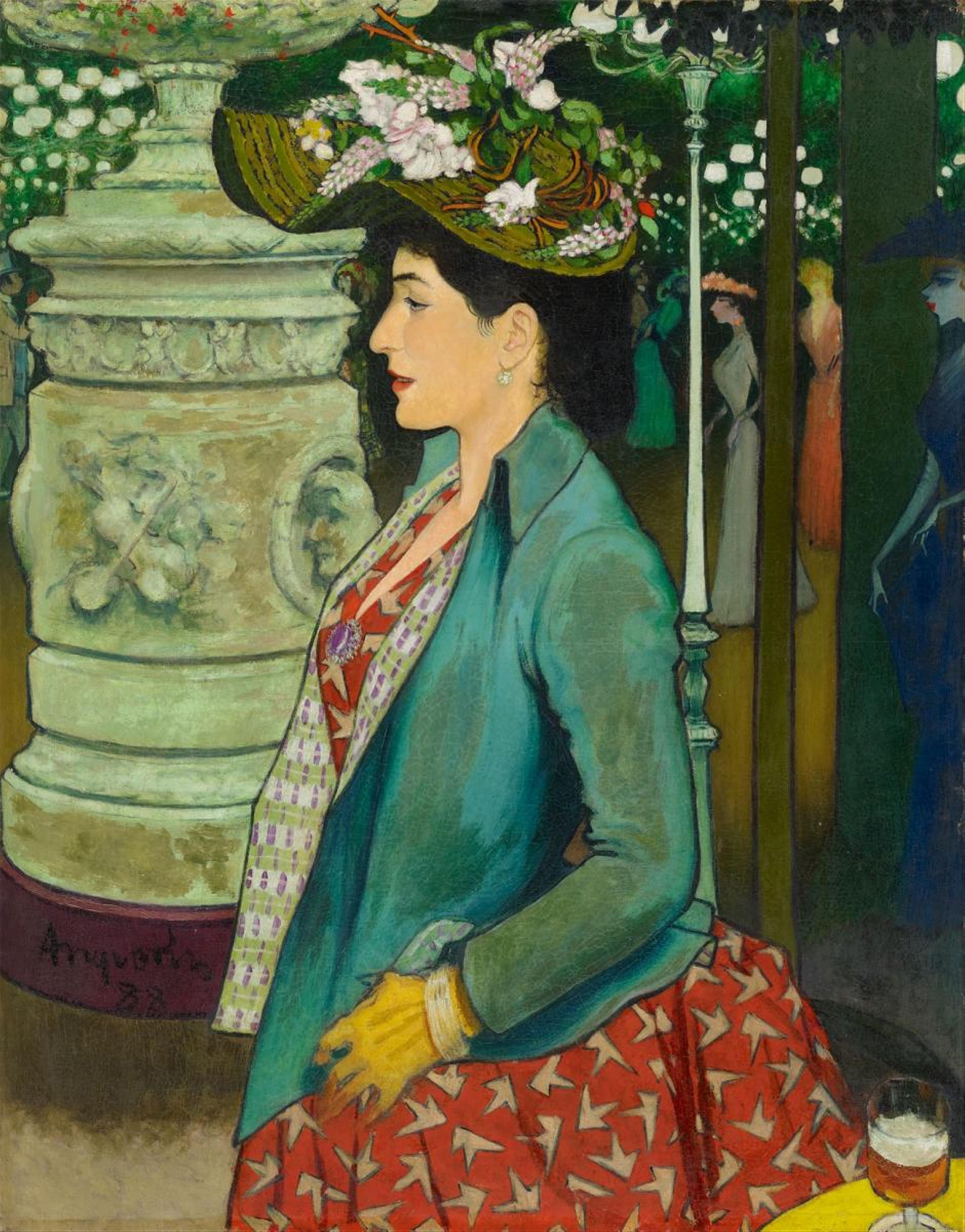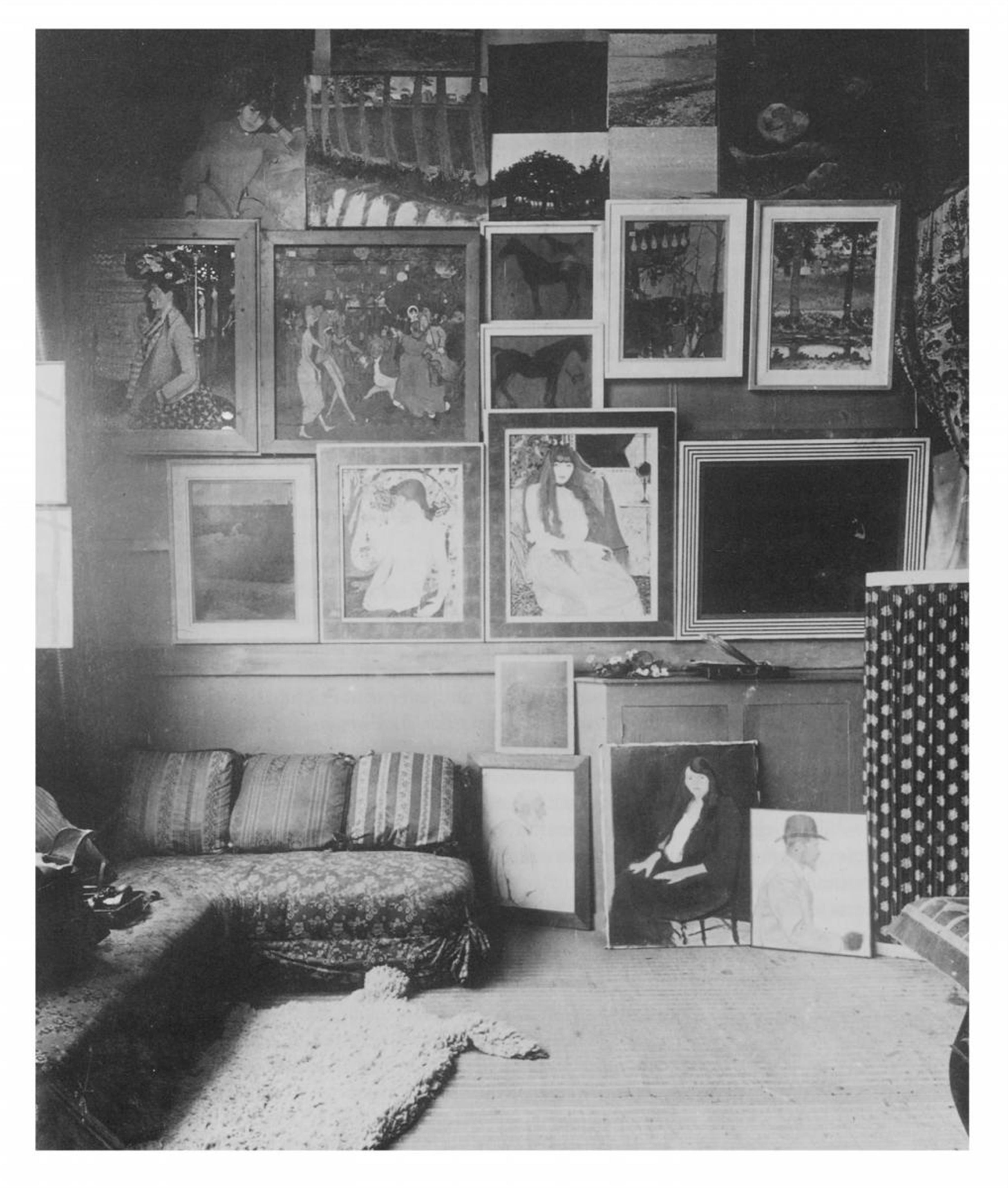Oil on canvas, relined, 90.5/91 x 72/72.5 cm, framed. Signed and dated 'Anquetin 88' in black to left of composition on base of pedestal. - The old canvas relined with wax. Increased craqueleur and old retouchings; with a superficial diagonal scratch to bottom left of picture recently restored.
Louis Anquetin largely became known as a painter of the 'petit boulevard', and this profile of an elegant passer-by set against an illuminated backdrop, among tall trees is about the 'Bal Mabille' on the Champs Élysées, an enjoyable public dance venue which appears to represent the atmosphere of a saturated 'belle époque' like none other. Nevertheless, we must not ignore a number of striking formal elements. The strictness of the composition, the static quality of the woman's decorative profile, the summary depiction of the backdrop and the elongated, cartoon-like figures in the background - all of these elements very clearly delineated with dark contours - were features that caused irritation and received comments as soon as the painting appeared:
“Au premier aspect [...], ces oeuvres donnent l'idée d'une peinture décorative, un tracé en dehors, une coloration violente et arrêtée, rappelant inévitablement l'imagerie et le japonisme (...) le travail du peintre sera quelque chose comme une peinture par compartiments analoques au cloisonné, et sa technique consistera en une sorte de Cloisonnisme,” said Edouard Dujardin in 'La Revue Indépendante' on 19 March 1888, commenting on the most recent works of Louis Anquetin at the Salon des Indépendants. With these words he coined a new artistic term which came to be historically associated with the stylistic thrust of Emile Bernard, Pont-Aven and the Nabis, although initially it was intended to describe Louis Anquetin (quoted from: Frédéric Destremau, Anquetin, op. cit. p. 109).
Anquetin and Toulouse-Lautrec were very close friends, which may explain the free yet formal and satirical character of this painting, with its random exaggeration and foreshortening of details. In 1884 the two were joined by Emile Bernard, and Vincent van Gogh also became part of the small artists' circle in 1886, during his stay in Paris. This deepened their theoretical debates on the experience of Japanese art. It was van Gogh who introduced Henri Toulouse-Lautrec, Emile Bernard and Louis Anquetin to Japanese woodcuts in 1887, both through the art dealer Samuel Bing and by showing them the prints which he and his brother Theo had started to collect - at the 'Café du Tambourin' on the Boulevard de Clichy Van Gogh had been presenting this unique collection. (See Cornelia Homburg, Vincent van Gogh and the Painters of the Petit Boulevard, exhib. cat. of Saint Louis Art Museum/ Städelsches Kunstinstitut Frankfurt, New York 2001, especially pp. 26 , 120 and 210). Van Gogh, in turn, benefited from this lively exchange among these friends and apparently had a very close look at their paintings.
This painting - which can still be seen on the artist's studio wall in a photograph taken in the 1890s (see comparative illus.) - was created during the year when Anquetin had reached the climax of his stylistic developments. In the same year he was also invited to exhibitions of the artists' group 'XX' in Brussels. During this period his art was characterised by bold perspectives, an artificial pictorial architecture, strong colour accents, emphasising planes and graphic contours. Although he eventually gave up his artistic experiments in favour of more conservative values in the second half of the 1890s, his earlier style continued to inspire other artists during that time in a way that may not be widely known.
“L'apport de Louis Anquetin est considérable. Eminemment doué, prodique et généreux, il a ouvert à l'expression plastique des champs insoupconnés, que lui-même n'exploitera pas, n'en saississant pas la portée, mais auxquels d'autres sauront donner leur pleine signification. Il occupe ainsi une place unique dans l'histoire du post-impressionnisme.” (Frédéric Destremau, Preface, in: exhib. cat., Brame & Lorenceau, op. cit., p. 10)
Certificate
With an expertise from Brame & Lorenceau, Paris, dated 11 October 2012; the painting is registered in the digital archive for the work of Louis Anquetin.
Provenance
Formerly Collection Josef Haubrich, Cologne (until 1961); in family posession since, private possession, South America
Literature
Frédéric Destremau, Anquetin, La Passion d'être Peintre, Ausst. Kat. Galerie Brame & Lorenceau, Paris 1991, Doc. 4, p. 14 (studio photo)




